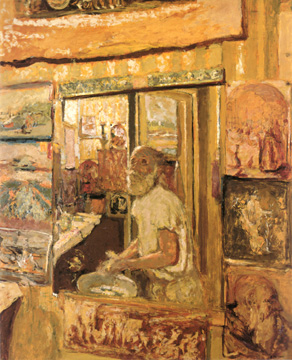The scene is the dining room of a Parisian apartment at night. The dramatis personae are the assembled members of the family of Edouard Vuillard. The space is confined and dark. The light of a single candle turns the far wall a rich, muted orange. Madame Vuillard bends over a tablelamp, holding a lit match to the frayed string of its wick. Her face is a smear, an almost featureless blur woven into her distinctive silhouette: stocky, squat, hair in a bun. Beside her two other silhouettes loom. The cloaked figure of the artist’s grandmother waits expectantly while his sister, Marie, brandishes a baguette like a weapon. Partially obscured by his grandmother’s cape, the painter himself peeps through the door. His face is gaunt and he looks possibly disconcerted, although it is hard to tell because he has left so little of himself visible – just a pair of beady eyes, a bit of nose, and a furrowed forehead.
Suppertime hangs at the start of the Royal Academy’s new exhibition of Vuillard’s work, an appropriately intriguing introduction to the art of this elusive, brilliant painter, with his contempt for academic naturalism and his ability to invest quotidian events with dramatic strangeness. Vuillard was the great stay-at-home of early modern French painting, living for much of his life with his mother (an arrangement that only ended with her death, by which time he was sixty years old). He loved his family but used them too, altered and reimagined them as the promptings of his art required.
The Royal Academy’s exhibition is the first retrospective of Vuillard’s painting to have taken place in this country for nearly forty years. While it contains many wonderful pictures from Vuillard’s youth and early maturity, albeit hung rather crowdedly, space has not been found for more...

Vuillard at the Royal Academy 2004
22-02-2004

